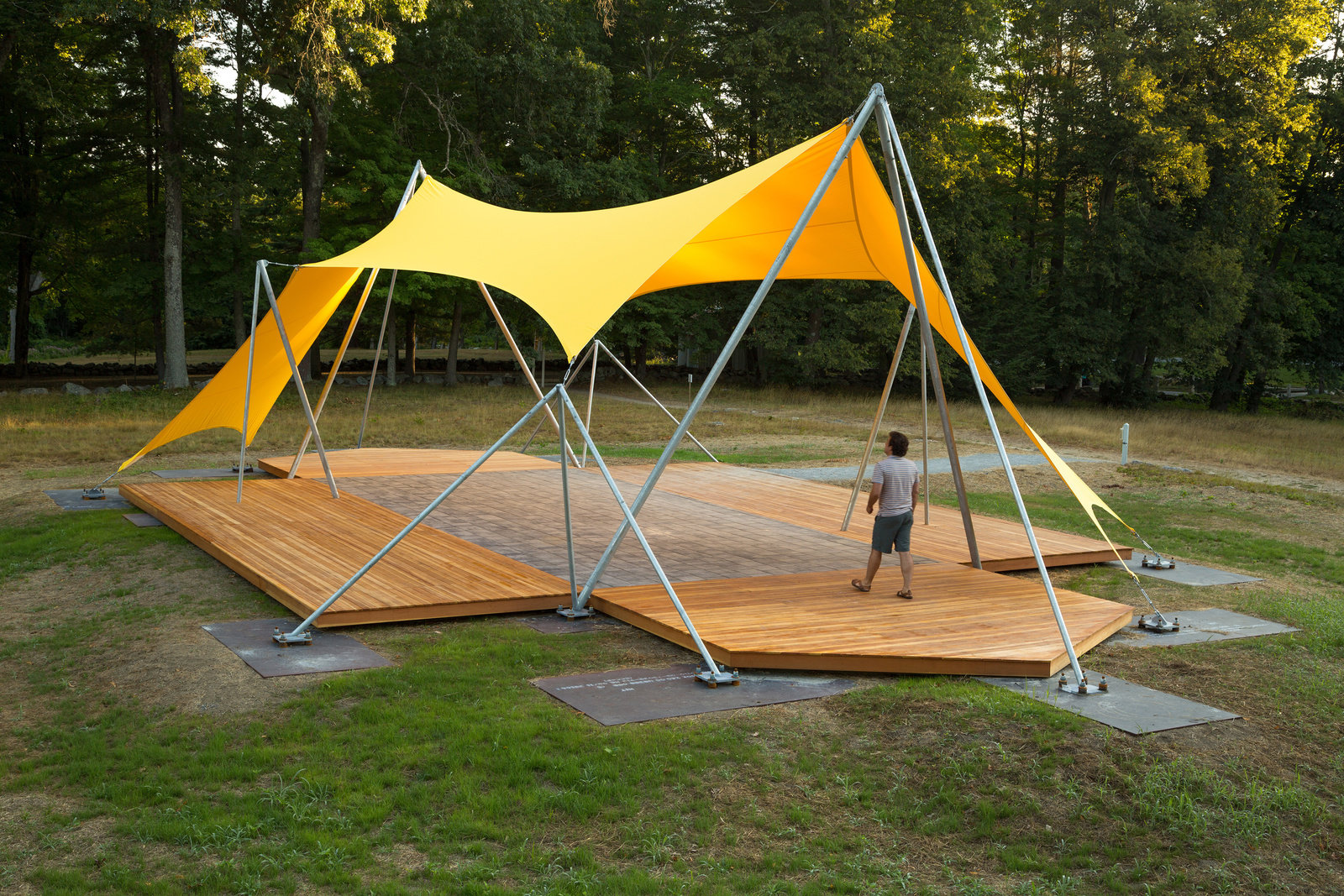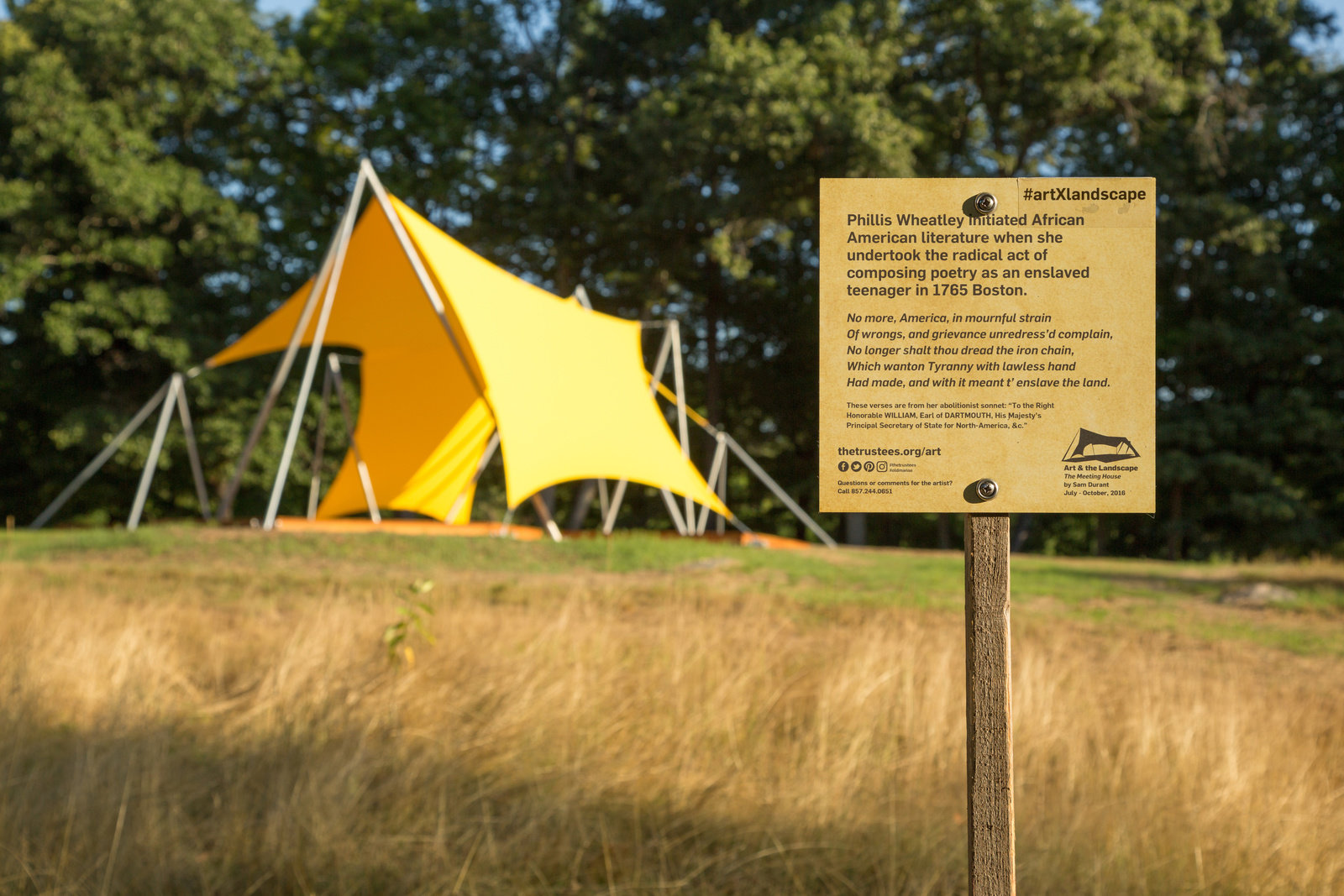Blum & Poe Broadcasts presents free and public access to scholarship and writerly ponderings from our publications archives.
In focus this week—excerpts from Sam Durant's The Meeting House / Build Therefore Your Own World (Los Angeles: Blum & Poe, 2017), on the artist's project contextualizing American canonical historical narratives alongside lesser-known histories of slavery and the treatment of African Americans, from the founding of the colonies to the present day.
From this project, Broadcasts features words by conflict resolution and reconciliation specialist Tim Phillips.


Pavilion at The Old Manse, Concord, MA
Photo: Alex Jones
Making the Invisible Visible: Art and Context as an Instrument of Social Change
I have spent the last twenty-five years working with leaders around the world who have struggled to move their countries from dictatorship to democracy and from conflict to peace. Using the shared human experience approach, which I developed in the early 1990s, my organization, Beyond Conflict, brings together leaders struggling with profound social and political change with those who previously led transitions in other countries. Our belief is that people can learn from the experience of others, and seeing that others have overcome similar, once-intractable problems provides them with the courage and capacity to lead positive change in their own countries and communities.
Using this approach, we have supported leaders in Central and Eastern Europe and the former Soviet Union as they confronted the legacy of seventy years of Communist rule and repression; helped South Africans to create their Truth and Reconciliation Commission in the painful aftermath of apartheid; encouraged leaders in Northern Ireland to imagine the possibility of peace after decades of division and violence; and worked to promote reconciliation in the aftermath of war in Central America and the Balkans. Most recently, we helped set the conditions for the breakthrough between Cuba and the United States after six decades of polarization, and we continue to promote reconciliation between both countries and to work with Cuban Americans seeking to find a new way forward in order to heal their community after decades of exile and suffering.
The shared human experience approach has proven to be a powerful and transformative model for change because it is founded on the recognition that individuals—no matter where they live, no matter their race, ethnicity, religion or gender—can learn from the experience of others who have struggled to overcome deep-seated fear and division, and through the example of those others to develop their own capacity to lead positive change.
Through my work, I have come to recognize that there are fundamental drivers of conflict and reconciliation that exist at the national, international, and personal levels. Drivers that are not defined by culture, ethnicity or geography, but are instead driven by one’s universal human need to be acknowledged, understood, and validated as one sees oneself. My experience shows that all conflict—whether at the national or personal level—is driven by exclusion, by the experience of being marginalized and ignored, and by the failure to recognize adequately and acknowledge the identity of others. Individuals and communities have a longing and a need to be included and to be agents of their own destinies. In fact, neuroscientists using brain-imaging technology have found that the brain registers social rejection the same way that it registers physical pain. The region of the brain that processes trauma cannot fully differentiate between emotional and physical trauma, and scientists tell us that we cannot fully access our capacity for rational thought until we feel that our identities are genuinely understood and valued by others.


Pavilion at The Old Manse, Concord, MA
Photo: Alex Jones
When I look at the profound challenges we face in the United States concerning race, inclusion, and the growing divide between different communities throughout the country, I see the same dynamics at play that I have seen around the world. This comes as no surprise. Human brains are wired the same way, no matter where their possessors live or what they do. Our survival as a species has depended on feeling safe, secure, and empowered to make decisions about our own futures as we envision them. These deep and basic human needs are the root of conflict and reconciliation, whether on the global stage or in our communities and families. Efforts to achieve peace in Northern Ireland and to end apartheid peacefully in South Africa succeeded only when all parties, even the smallest and most marginalized, were brought to a table where the dominant parties did not impose their will, and when communities felt they had agency over their own future—in short, when they felt acknowledged, valued, and safe.
When one looks at the tensions in the world today, one witnesses an urgent and growing demand from individuals and communities to be heard and recognized as fully human, that is, seeking to be treated with dignity, respect, and as equal members of a shared community. The most powerful and transcendent lessons we can learn from other nations that have experienced profound change is that peace and reconciliation became truly possible only when all groups in a given country were included in every important decision about their future. As one leader in Northern Ireland so eloquently said, “nothing about us, without us.”
Behavioral science overwhelmingly confirms that there is a biological basis for much of our behavior—particularly for our powerful need to be included, acknowledged, and seen as we see ourselves. Research on sacred values—those values we hold that are above compromise and that are key to our identity and sense of place in the world, such as the protection of our children, the principles of our religion, or family honor—are processed in different regions of the brain than more utilitarian or businesslike thoughts. The research shows that when we are asked to compromise our sacred values, we hold on to them more deeply and respond with anger and aggression. It is only when our sacred values are recognized by others that we begin to listen. When we don’t feel under threat, when our core identities are acknowledged as we define them, then we are able to think rationally and begin the process of opening our minds to others with views fundamentally different than our own.
With these powerful insights, gleaned from experience and confirmed by science, it is clear, and powerfully so, that artists, particularly visual artists, have a vital and unique role to play in helping individuals to navigate these powerful realities. Art, at its best, fundamentally challenges the way that we see the world and confronts us with realities that beg us to look deeper at what we believe to be true. Artists have the power to reveal truths when words alone are not enough to make others hear and see. Art can force the viewer to consider other realities and other narratives; to recognize connections where other means fail to do so.


Commissioned and produced by The Trustees of Reservations as part of Art and The Landscape, Photo: Above Summit
But to stop at revealing certain truths without providing context would be a disservice to the pursuit of truth. For what behavioral science clearly demonstrates and experience confirms is that empathy—the biological capacity of members of our species to place themselves in the minds of another and access a part of the other’s truth—is dependent on context and proximity. The searing and disturbing image of the young Syrian boy, Alan Kurdi, who drowned as his family sought refuge in Europe and washed up on the beach in Turkey, did more to connect the world to the brutality of war in Syria then the thousands of images of civilians fleeing bombed-out Aleppo and the countless other moments of suffering and death that were reported. The unique power of that truth came from the reality that we all could imagine that child belonging to us. He was dressed in shorts and sneakers, and his young, lifeless body was washed up on a beach that looked like a beach on which we may have once vacationed. Seeing that young boy in a context that our minds could access so directly and unconsciously resulted in more awareness and attention to the plight of Syrian refugees than all the news stories and photos that documented the many horrors of the war in Syria.
At this troubling and uncertain time, when social divides are deepening and trust is declining, we must find ways to connect. Artists must not only reflect painful and necessary truths, but they must strive to present them in contexts that allow us to see something about ourselves and to see our own lived experience in others. There is so much that divides us simply by being human. We differ by our social, ethnic, cultural, religious, racial, and political identities. But we are also united by shared values and, most profoundly, by the shared need to feel understood and acknowledged, to feel respected and to have impact on our worlds.
This context, this ability to give meaning, to give voice to others, to empathize with those profoundly different from them, is what leaders from South Africa and Northern Ireland learned to navigate as they sought to end war and repression and reconcile their deeply divided nations. It is what great artists have always been able to do on the personal level. Art is about giving voice, about making the invisible visible and showing us truths about the human experience that we might not otherwise see. Sam Durant did that powerfully at the Old Manse in Concord, Massachusetts. The Lyceum he created, literally on one of the most sacred grounds in American history, powerfully contextualized narratives we knew about the first battle of the American Revolution alongside narratives we didn’t know about the history of slavery and the treatment of African Americans, from the founding of the colony to the present day. Durant placed unknown and often uncomfortable narratives about African American life in Concord over three centuries in the context of a space that is about liberty, freedom, and human dignity. The viewer wasn’t shouted down or humiliated. The viewer was presented with deep and painful truths in a setting that was about liberty, about farmers who wanted to define for themselves what community and inclusion looked like. By providing context and challenging the visitor with other truths, other narratives, Durant offered the visitor the tools to think, to question and to engage. Visitors to that site may not remember everything that was said in the Lyceums, but they won’t forget that in that space they learned something about others that they won’t easily forget.
Conflict and reconciliation within the United States is no different than conflict and reconciliation around the world—and our challenge of navigating increasingly complex subjective truths is equally profound. We must begin to think deeply about the lived realities of those different from us. This begins with acknowledging our shared humanity, our common need to be heard, understood, and included in fundamental decisions that shape our future; and it begins by inviting those curious enough to explore what is across that threshold—however we define it.